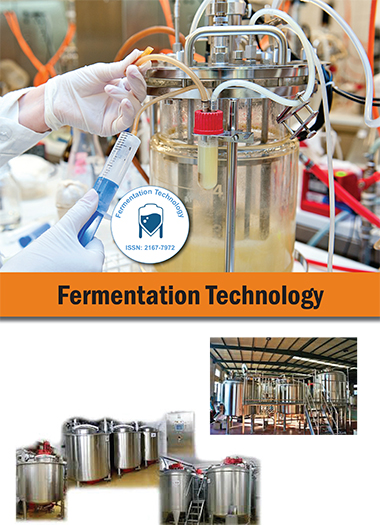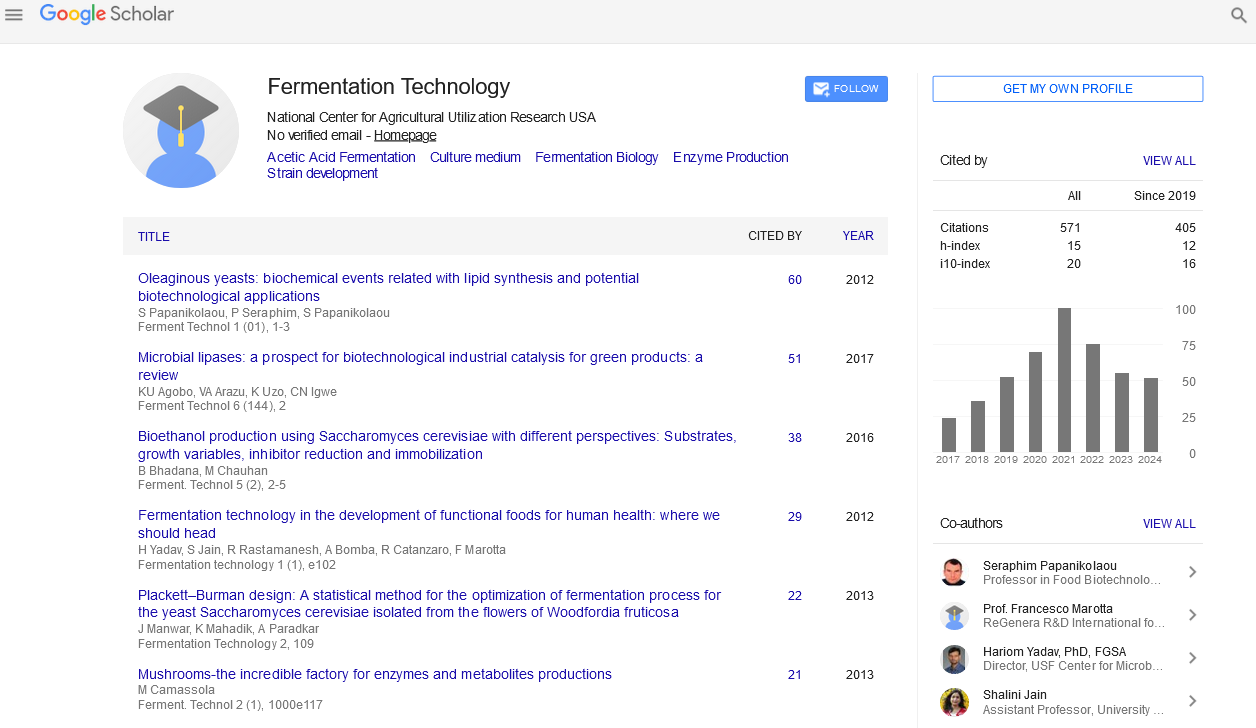Indexed In
- Open J Gate
- Genamics JournalSeek
- Access to Global Online Research in Agriculture (AGORA)
- RefSeek
- Hamdard University
- EBSCO A-Z
- OCLC- WorldCat
- Publons
Useful Links
Share This Page
Journal Flyer

Open Access Journals
- Agri and Aquaculture
- Biochemistry
- Bioinformatics & Systems Biology
- Business & Management
- Chemistry
- Clinical Sciences
- Engineering
- Food & Nutrition
- General Science
- Genetics & Molecular Biology
- Immunology & Microbiology
- Medical Sciences
- Neuroscience & Psychology
- Nursing & Health Care
- Pharmaceutical Sciences
Opinion Article - (2025) Volume 14, Issue 1
Valorization of Food Waste through Anaerobic Fermentation: A Circular Bio-Economy Approach
Vincent Richardson*Received: 26-Feb-2025, Manuscript No. FMT-25-29075; Editor assigned: 28-Feb-2025, Pre QC No. FMT-25-29075 (PQ); Reviewed: 13-Mar-2025, QC No. FMT-25-29075; Revised: 20-Mar-2025, Manuscript No. FMT-25-29075 (R); Published: 27-Mar-2025, DOI: 10.35248/2167-7972.25.14.185
Description
Globally, over one-third of all food produced is wasted, resulting in environmental pollution, economic loss and resource inefficiency. Addressing this issue requires sustainable waste management solutions that not only reduce waste but also recover valuable resources. Anaerobic fermentation presents a promising method to convert food waste into biogas, organic acids and other value-added products. This approach supports circular bio-economy models, where waste is transformed into useful inputs, closing resource loops and reducing dependence on fossil resources.
Food waste as a feedstock
Food waste is a rich substrate containing carbohydrates, proteins, lipids and micronutrients, making it suitable for microbial fermentation. Typical sources include kitchen scraps, expired groceries, vegetable trimmings, dairy leftovers and bakery discards.
However, its heterogeneous composition, variable moisture content and potential contamination require careful pretreatment. Common steps include sorting, grinding, dilution and pH adjustment to prepare the material for fermentation. Some systems integrate heat or enzymatic hydrolysis to enhance substrate availability.
Anaerobic fermentation principles
Anaerobic fermentation involves microbial breakdown of organic material in the absence of oxygen. The process occurs in four main stages:
- Hydrolysis – Complex polymers are broken down into monomers (e.g., sugars, amino acids).
- Acidogenesis – Monomers are converted into short-chain organic acids, alcohols, hydrogen and carbon dioxide.
- Acetogenesis – Intermediates are further metabolized into acetic acid, CO2 and hydrogen.
- Methanogenesis – Methanogens convert acetic acid and hydrogen into methane and CO2.
By controlling environmental conditions, it is possible to steer fermentation toward desired outcomes such as biogas production or accumulation of specific acids (e.g., lactic, butyric, or acetic acid).
Process conditions and reactor types
Anaerobic fermentation operates effectively under mesophilic (30–40°C) or thermophilic (50–60°C) conditions. Key operational factors include:
- pH – Typically maintained between 6.5 and 7.5.
- Hydraulic Retention Time (HRT) – Adjusted based on substrate complexity and reactor design.
- Mixing – Promotes uniformity and prevents stratification.
- Organic Loading Rate (OLR) – Needs to be balanced to avoid overloading and acidification.
Various reactor configurations are used for food waste fermentation:
- Continuous Stirred Tank Reactors (CSTRs) – Offer effective mixing and scalability.
- Upflow Anaerobic Sludge Blanket (UASB) – Suitable for liquid-rich substrates with high flow rates.
- Anaerobic Sequential Batch Reactors (ASBRs) – Provide operational flexibility and high biogas yields.
Products and applications
Biogas: Composed mainly of methane and carbon dioxide, biogas is used for heating, electricity generation, or upgraded to bio-methane for vehicle fuel.
Digestate – the residue left after fermentation – is often applied as a bio-fertilizer.
Volatile Fatty Acids (VFAs): Acetic, propionic and butyric acids have industrial relevance in polymer synthesis, solvents and feed additives.
Hydrogen gas: Dark fermentation can produce hydrogen as a clean energy carrier, though yields are often lower than those of biogas.
Organic acids for bioplastics: Lactic and succinic acids derived from food waste fermentation are building blocks for biodegradable plastics.
Integration with circular bioeconomy
The concept of circular bioeconomy emphasizes resource recovery, waste minimization and renewable input cycles. Anaerobic fermentation aligns well with these goals by:
- Reducing landfill dependency and associated greenhouse gas emissions.
- Generating renewable energy and bio-based chemicals.
- Recycling nutrients back into agricultural systems (digestate).
- Supporting decentralized waste management, especially in urban and peri-urban areas.
Community-scale biogas plants can serve local energy needs, while industrial facilities may focus on large-scale waste treatment and resource recovery.
Environmental and economic benefits
Anaerobic fermentation reduces environmental burdens by diverting organic waste from landfills, which are major sources of methane emissions. Controlled fermentation captures this gas for energy use, converting a pollutant into a valuable resource.
Economically, the process creates value from waste, reducing disposal costs and generating revenue from energy sales and digestate utilization. Coupling fermentation with other technologies, such as composting or algae cultivation, enhances resource recovery.
Challenges and research directions
Despite its potential, several barriers remain:
- Feedstock variability: Inconsistent composition affects process stability and product yield.
- Inhibitor accumulation: Certain compounds in food waste can hinder microbial activity (e.g., salt, cleaning agents, fats).
- Public perception: Concerns about odor, safety and aesthetics may affect community acceptance.
- Regulatory frameworks: Clear policies are needed to standardize digestate use and biogas integration into national grids.
Research is focusing on microbial consortia optimization, co-digestion strategies (e.g., mixing food waste with manure or crop residues) and reactor innovations for enhanced efficiency.
Conclusion
Anaerobic fermentation offers a sustainable solution to the global food waste problem by converting organic residues into energy and valuable bio-chemicals. By integrating this process into broader circular bio-economy systems, communities can improve resource use, reduce emissions and promote local energy independence. With supportive policies and continued technological advancement, food waste fermentation has the potential to play a major role in achieving global sustainability targets.
Citation: Richardson V (2025). Valorization of Food Waste through Anaerobic Fermentation: A Circular Bio-Economy Approach. Ferment Technol. 14:185.
Copyright: © 2025 Richardson V. This is an open-access article distributed under the terms of the Creative Commons Attribution License, which permits unrestricted use, distribution and reproduction in any medium, provided the original author and source are credited.

